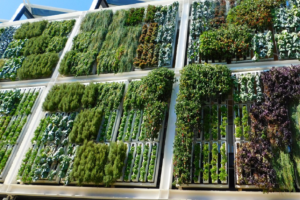In the current scenario with an increase in the hyperdensity of cities, people are forced to expand vertically rather than horizontally on the earth’s surface. It is not just towers, high rise buildings or apartment buildings that are reaching skyward; we now have vertically expanding gardens, commercial farms and green facades. Many people don’t have enough space to grow a garden and are often forced to look at container gardening as their only option. But now you can always consider vertical gardening in a small space.
A new era of landscape design has been introduced with the concept of living walls or vertical gardens. It is a perfect solution for all kinds of interior and exterior work such as terraces, receptions, hotels, building facades, etc.
The trend of sustainability is putting forward a very interesting and important approach between architecture and the environment. One of these approaches is facade greening which has started to play an important role in climate-responsive architecture. It’s not an innovation but rather a new concept that has proved to be an excellent energy-saving method.
Environmental Impacts of Green Facade
Many experts suggest that vegetation on building facades can be effective on many levels of sustainable performance. Vertical gardens can help in regulating microclimate of the building; combining roofs and facades of the buildings can also impact the macroclimate of the region.
Temperature reduction
Vegetation can drastically reduce the maximum temperature of the building as it shades all from the heat associated with solar gain. Through evaporation and transpiration, a massive amount of solar radiation can be converted into latent heat which prevents the temperature from rising. It acts as a barrier, blocking the transmission of plant radiation from the interior as well as exterior, becoming a potential tool of isolation.

Artificial lighting load
A facade can be designed in a way building gets the optimum amount of natural daylight which could reduce the artificial lighting in the internal environment. Over illumination that results in glare and overheating can be prevented through planting vegetation. It reduces HVAC load and occupants’ discomfort. Window to wall ratio, assembling of windows and glazing properties of glass needs to be taken care of.
Biodiversity
Rapidly increasing urbanization has resulted in the reduction of green spaces. The interaction between human activities and biodiversity has become more and more difficult. The implementation of vertical garden systems in urban dwellings creates a habitat for flora and fauna. However, it needs to be considered that different plant species require different living conditions. Hence, the type of plantation needs to be chosen carefully.
Sound isolation
Increasing transportation and the urban population have brought with it the problems of noise pollution. Vertical garden systems offer the best way to avoid the negative effects of noise pollution. It can be used as a noise barrier. The depth of growing media, the material used in the structural component, type of plant species used; all these factors help in reducing the noise level inside the building.
Reduces urban heat island effect
Urban heat island (UHI) effect means that the urban temperature is higher than the surrounding regions due to urbanization. During the day time, concrete surfaces of the building absorb the solar gain which is released during the night time because of convection. This increases the overall temperature of the city. The vertical garden helps in reducing this effect by increasing the evaporation surface and reflecting back sun rays.

Applications of vertical gardens
- Apart from the facade of the buildings, vertical gardens can be installed in the interior of the houses or offices. It enhances the aesthetics of the internal environment. Such gardens are used in reception areas, cafeterias, community buildings, etc which adds to the ambiance of the structure.
- These gardens can be added in very small spaces like balconies, backyards, etc where there is no space available for gardening.
- Bio-active green facades: The first bio adaptive facade was built in Hamburg, Germany in 2013 by an engineering firm Arup. Microorganisms provide a continues supply of carbon dioxide with liquid nutrients that are transferred through a water circuit to the technical room where it is fermented in a biogas plant. The process generates renewable energy and provides a shaded environment for the occupants inside the building.
It helps in improving air quality and climatic balance of the surroundings. Vertical gardens are beautiful, space-saving and sustainable in addition to our urban dwellings.

